The nineties were a beautiful disaster for children's nutrition. While parents thought they were giving their kids fun treats, we were essentially consuming science experiments wrapped in colorful packaging. Those seemingly innocent snacks contained enough artificial ingredients to make a chemistry teacher blush. Looking back with adult eyes reveals just how wild those lunchbox staples really were. Let's dive into the nutritional nightmares that defined a generation.
Lunchables: The Ultra-Processed Lunch Revolution

These convenient little boxes changed lunchtime forever, though not necessarily for the better. A single serving of Ham and Swiss Lunchables contained around 950mg of sodium, with some varieties reaching up to 1,200 milligrams, which is 47% of the recommended daily allowance for an adult. That's nearly half an adult's daily sodium limit packed into a child-sized meal.
The turkey and cheese version contains tertiary-butyl hydroquinone (TBHQ), a petroleum-based chemical found in pesticides, plus sodium diacetate, carrageenan, and sodium nitrate, a preservative linked to cancer. Modern testing has revealed even more concerning findings. A 2024 Consumer Reports study found high concentrations of lead and phthalates in Lunchables products.
The "pizza" version was particularly questionable. It featured a spongy, Frisbee-shaped "crust" topped with ketchup-like sauce, shredded "mozzarella cheese product," and pepperoni disks made from pork, mechanically separated chicken and beef, all eaten cold.
Gushers: Sugar Bombs Masquerading as Fruit

The first three ingredients in Gushers were all forms of sugar: sugar, corn syrup, and dried corn syrup. Despite being marketed as fruit snacks, they contained virtually no actual fruit. These sugary treats had approximately the same nutritional value as a handful of gummy bears.
General Mills faced a lawsuit for claiming there were "no artificial flavors" even though they used DL-malic acid, which is synthetically made from petroleum. That chewy exterior and gooey center that kids loved was essentially a carefully engineered delivery system for multiple types of sugar.
The brand originally launched with just strawberry and grape flavors, but expanded rapidly as kids became addicted to that signature "gush" of artificially flavored liquid.
Surge Soda: The Nuclear Green Energy Drink

Surge contained 56 grams of sugar per can - nearly twice the amount in Coca-Cola - and 51mg of caffeine. That sugar content was equivalent to 14 teaspoons of granulated sugar in a single can. Coca-Cola marketed it as "A Fully Loaded Citrus Soda," which was surprisingly accurate advertising.
The drink was promoted as having "a considerable number of carbohydrates" and used maltodextrin for a longer-lasting blast of energy. Essentially, they created an energy drink for teenagers and called it soda. Parents reported children becoming jittery and unable to focus after drinking it, leading school administrators in Denver and Seattle to ban it from campus vending machines.
Wonder Balls: Chocolate Shells of Chaos

Each Wonder Ball contained approximately 170 calories, with 19 grams of sugar and 9 grams of fat in a single serving, featuring massive amounts of sugar and fat per candy. These hollow chocolate spheres came packed with tiny toys and candy pieces, creating a perfect storm of choking hazards and sugar overload.
The concept was brilliant from a marketing perspective but terrifying from a safety standpoint. Kids would crack open these chocolate shells to find small plastic toys mixed with additional candy, essentially combining dessert with potential emergency room visits.
The product disappeared quickly, likely due to safety concerns, but not before creating lasting memories for kids who managed to consume them without incident.
Squeezits: Artificial Neon Juice

These fruit-flavored plastic bottles contained 100 calories and 23.6 grams of sugar per serving, described as "artificial neon 'juice' packed with enough sugar to make any modern parent faceplant into their oat milk." The bright, unnatural colors were the first warning sign that these weren't remotely related to actual fruit.
Nobody really knew what chemicals were in the bright-colored Squeezits aside from sugar. The plastic bottles could be squeezed to create dramatic color combinations, which was entertaining but probably not advisable from a food safety perspective.
Having a Squeezit in your lunch was a status symbol among elementary school kids, though the ingredients list read more like a chemistry experiment than a beverage.
Fruit by the Foot: Three Feet of Artificial Fun

The '90s version was extra psychedelic and almost 50% sugar, which may account for about a decade of sugar highs. These colorful strips were marketed as fruit snacks, but the "fruit" content was essentially nonexistent. Kids would unroll the three-foot-long strips and tie them around their heads or read tongue twisters printed on the packaging.
The artificial colors were so intense they would sometimes stain children's tongues bright blue or green for hours. Parents probably should have questioned why a "fruit" product could achieve such vibrant, unnatural colors.
The entertainment value was undeniable, but nutritionally speaking, kids were essentially eating flavored plastic strips loaded with sugar and artificial everything.
Sunny Delight: Orange-Flavored Sugar Water

Commercials marketed Sunny D as containing "healthy junk" and being "the good stuff that kids went for," though knowing what we know now, parents aren't likely to let their kids chug the sugary sweet beverage with gusto. The drink was positioned as a healthier alternative to soda, which was laughable considering its ingredient list.
Despite being orange-colored, Sunny D contained minimal actual orange juice. The primary ingredients were water, high fructose corn syrup, and artificial flavors. The marketing genius was convincing parents this was somehow better than juice boxes.
Kids loved the tangy, artificially enhanced citrus flavor, while parents felt good about choosing something that wasn't technically soda. Everyone was fooling themselves.
Pop Rocks: Carbonated Candy Chaos

These were tubes of pure sugar that little kids poured directly into their mouths - what could go wrong? Pop Rocks contained pressurized carbon dioxide that created explosive sensations in children's mouths. The sugar content was astronomical, and the experience was designed to be as intense as possible.
Urban legends circulated about kids' stomachs exploding from combining Pop Rocks with soda, though these were thankfully unfounded. However, the candy was essentially training children to enjoy increasingly intense flavor experiences.
The crackling sensation was achieved through a manufacturing process that involved exposing sugar to pressurized carbon dioxide, creating tiny sugar crystals filled with compressed gas that would explode when exposed to saliva.
Butterfinger BBs: Bite-Sized Sugar Bombs

These were just smaller versions of Butterfingers, but there was an irresistible Simpsons tie-in, and if they were good enough for Bart Simpson, they were good enough for '90s kids. The smaller format made them seem less harmful, but kids would consume entire bags in single sittings.
The peanut butter and chocolate combination was engineered to be as addictive as possible, with the perfect ratio of sugar, fat, and artificial flavoring. The bite-sized format encouraged mindless consumption rather than treating candy as an occasional indulgence.
Parents felt better about giving kids "BBs" instead of full-size candy bars, not realizing that children would easily consume the equivalent of multiple candy bars worth of sugar and artificial ingredients.
Planters Cheez Balls: Artificial Orange Puffs

Planters put Mr. Peanut's face on a can of Cheez Balls that shaped childhoods despite being discontinued. These bright orange, artificially flavored puffs came in distinctive metal cans and were impossible to stop eating once opened. The powder coating would stain fingers bright orange for hours.
The "cheese" flavor was entirely artificial, created through a combination of chemicals designed to trigger pleasure centers in the brain. Kids would polish off entire cans while watching Saturday morning cartoons, consuming enormous amounts of artificial colors, preservatives, and sodium.
The metal packaging gave them an almost industrial feel, which was probably appropriate given the heavily processed nature of the product inside.
Dunkaroos: Cookie-Frosting Combinations

Dunkaroos were the snack every kid wanted to see when they opened their lunchbox. The concept was simple but nutritionally horrifying: bland cookies paired with artificially flavored frosting for dipping. Kids were essentially eating cake frosting with a spoon, using cookies as the delivery mechanism.
The frosting contained enough artificial colors and flavors to create rainbow-bright swirls, while the cookies provided minimal nutritional value beyond refined flour and sugar. The portion sizes encouraged kids to consume both components entirely in one sitting.
Parents appreciated the individual packaging and perceived portion control, not realizing they were essentially packing dessert for lunch disguised as a snack.
Cosmic Brownies: Space-Age Sugar Rectangles

These little cupcakes featured chocolate frosted layers that kids would peel off, with ingredient lists containing appealing words like "titanium dioxide" and "hydrogenated tallow." The colorful candy-coated chocolate chips on top contained enough artificial coloring to make them look like tiny UFOs.
The brownies were engineered for maximum shelf life rather than nutrition, packed with preservatives and stabilizers that would keep them "fresh" for months. The chocolate flavor came primarily from artificial sources rather than actual cocoa.
Kids loved the ritual of carefully removing the chocolate frosting layer before eating the cake portion, unknowingly consuming industrial food additives designed to create the perfect processed food experience.
The Sweet and Scary Reality

These foods shaped an entire generation's relationship with eating, teaching kids that food should be colorful, convenient, and constantly sweet. Many fantastic '90s snacks disappeared due to shifting consumer preferences and changing nutritional guidelines, though nobody really knew what chemicals were in many of these bright-colored products aside from sugar.
Today's nutritionists would be horrified by the combination of artificial everything, astronomical sugar content, and complete absence of actual nutritional value that defined '90s kid food. Yet somehow, we all survived to tell the tale.
What would you think about today's parents discovering their kids' lunchboxes filled with these nutritional nightmares? Tell us in the comments which '90s snack you miss most, despite knowing better now.





Leave a Reply